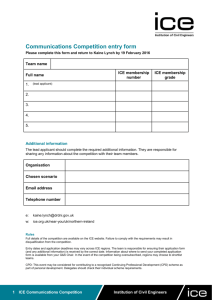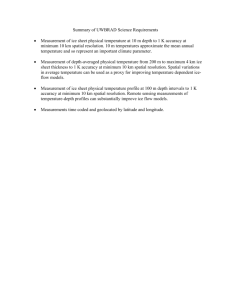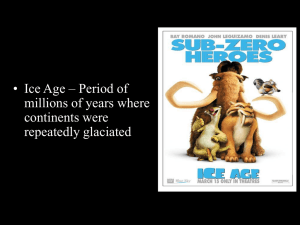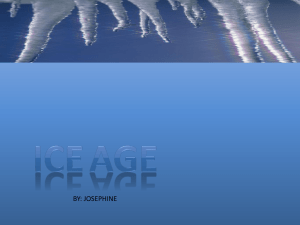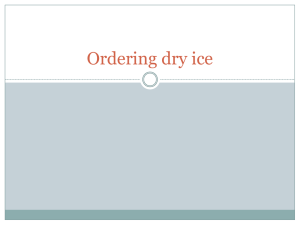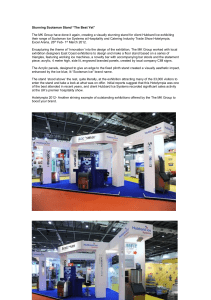module8_RG
advertisement
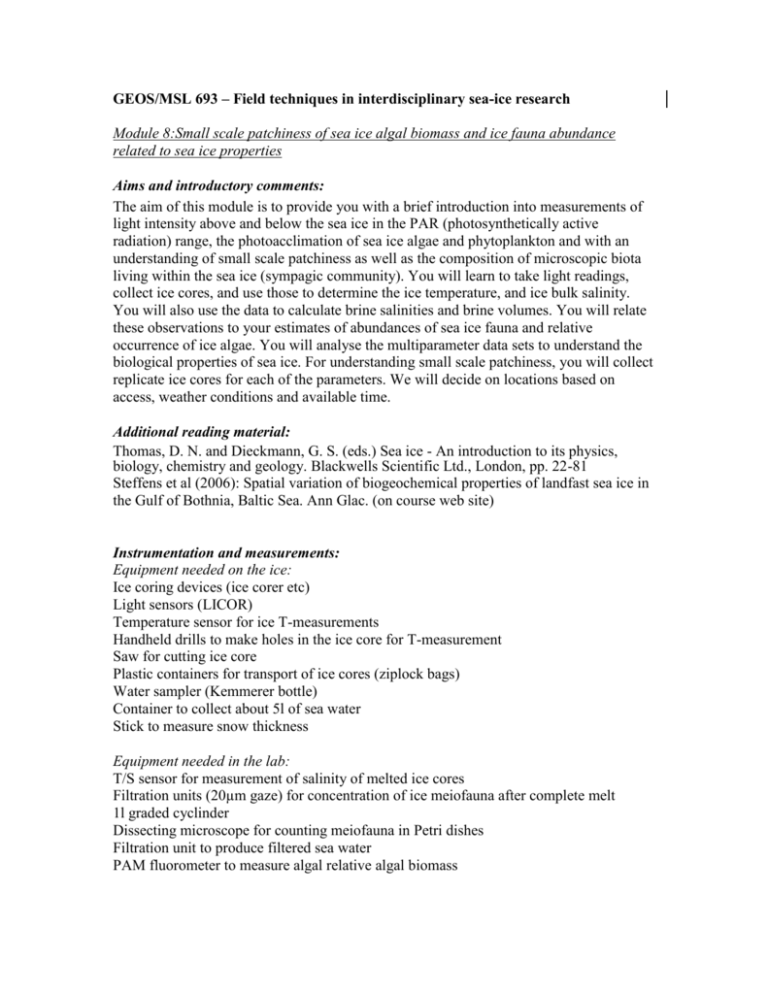
GEOS/MSL 693 – Field techniques in interdisciplinary sea-ice research Module 8:Small scale patchiness of sea ice algal biomass and ice fauna abundance related to sea ice properties Aims and introductory comments: The aim of this module is to provide you with a brief introduction into measurements of light intensity above and below the sea ice in the PAR (photosynthetically active radiation) range, the photoacclimation of sea ice algae and phytoplankton and with an understanding of small scale patchiness as well as the composition of microscopic biota living within the sea ice (sympagic community). You will learn to take light readings, collect ice cores, and use those to determine the ice temperature, and ice bulk salinity. You will also use the data to calculate brine salinities and brine volumes. You will relate these observations to your estimates of abundances of sea ice fauna and relative occurrence of ice algae. You will analyse the multiparameter data sets to understand the biological properties of sea ice. For understanding small scale patchiness, you will collect replicate ice cores for each of the parameters. We will decide on locations based on access, weather conditions and available time. Additional reading material: Thomas, D. N. and Dieckmann, G. S. (eds.) Sea ice - An introduction to its physics, biology, chemistry and geology. Blackwells Scientific Ltd., London, pp. 22-81 Steffens et al (2006): Spatial variation of biogeochemical properties of landfast sea ice in the Gulf of Bothnia, Baltic Sea. Ann Glac. (on course web site) Instrumentation and measurements: Equipment needed on the ice: Ice coring devices (ice corer etc) Light sensors (LICOR) Temperature sensor for ice T-measurements Handheld drills to make holes in the ice core for T-measurement Saw for cutting ice core Plastic containers for transport of ice cores (ziplock bags) Water sampler (Kemmerer bottle) Container to collect about 5l of sea water Stick to measure snow thickness Equipment needed in the lab: T/S sensor for measurement of salinity of melted ice cores Filtration units (20µm gaze) for concentration of ice meiofauna after complete melt 1l graded cyclinder Dissecting microscope for counting meiofauna in Petri dishes Filtration unit to produce filtered sea water PAM fluorometer to measure algal relative algal biomass Ice coring There is no need to hurry while you are coring – however as soon as a core is taken, make sure that you process the core as fast as possible, as temperature and bulk salinity (brine drainage) will change on a short time scale. Also do not expose any core for biological sampling to direct sunlight, as this can alter their biological performance. Also for all following measurements – collect three replicate set of cores (CORE A1-3, CORE B1-3) as well as three replicate sets of water samples. CORE A1-3 Take 10 readings of the snow depth at the coring site and then take one ice core (CORE A1). Only two people should work on this coring effort, as the same location will be used for light measurements. Measure the temperature in the ice core immediately after coring. Use the small drill to make holes half way through the core. Stick the temperature sensor into the holes and take a reading (units: °C). Make sure the reading is stable before you write it down. Repeat this process over the entire ice thickness with a vertical resolution of 10 cm. The temperature measurement is only done for core A1 (to safe time). After completing the temperature profile, cut the ice core with the saw into 10cm long sections and put those into labeled boxes. Ensure that you do not mix up the orientation of the ice core. Also keep track of segment depths and the numbers on your containers. Put all containers in one box (action packer or cooler). Label the core segment bags as follows: CORE A1 0-10cm, CORE A1; 10-20cm etc. After coring all the way through the ice, measure freeboard (the distance between the ice surface and sea level (in this case water level in your core hole). Repeat this process for the cores A2 (only bottom 10cm) without temperature measurements. For core A3: cut the bottom 10cm into the following sections: 0-1, 1-5, 5-10cm to estimate the vertical gradient of properties. Product: Produce a data sheet, containing depth data and ice temperature data. Include also a measurement of the air temperature. A second data table contains a complete list of containers with the related ice depths for each segment. Light: Light measurements in the PAR (photosynthetically active radiation: 400-700nm) range will be done with LICOR surface 2π and under-water 4π sensor attached to a LICOR LI1400 datalogger. The two light sensors will be connected to the datalogger on the ice. The light sensors are extremely fragile and should be handled with greatest care only under supervision of an instructor. The 2π sensor is NOT waterproof and cannot be lowered into the water. Both sensors determine photon flux densities (PFDs, µmol photons m-2 s-1), which is the relevant unit for understanding the relation between algal activity (photosynthesis) and absorbed light in the PAR range. Use the hole in the ice, where core A has been taken. Ensure that the surface has not been disturbed by the group. Lower the 4π sensor through the hole to a water depth of 2m – take simultaneously a reading from the 2π and 4π sensor. Repeat this process over a time period of 10min every min to study short term changes in the incoming radiation and how that is reflected in the under-water light field. After measuring the light intensity, ensure that the instrument is stored securely in a box. Note the time of day, when you did the measurement. Also note the overall weather conditions (sunny, overcast, cloud cover, fog). Product: Produce a data sheet containing 10 readings from the 2π and 4π sensor over a time span of 10 min. Ice cores for ice meiofauna counts CORE B1-3. Take a second set of ice cores (Set B) at a distance of approximately 1m from the sampling location of the A cores. Do not take a second temperature profile. We will only collect the 3 10cm section of the cores in labeled ziplock bags. Ensure that you keep track of segments and bag labels (suggested label: COREB1;0-10cm, COREB2, 0-10cm, Core B3: 0-1, 1-5, 5-10cm etc). Note the entire core length and the snow thickness for each of the cores. Product: Produce data sheet containing core lengths, segments and related container numbers Plankton net sample You will collect plankton (water column) animals using a 20um plankton net. Lower the plankton net to 5m depth (check water depth, that the net is not lowered into the sea floor) and bring it slowly back to the surface. Empty the content of the net carefully in a bottle and store the bottle in an insulated container to avoid heating or freezing of the sample. Water samples: Lower the Kemmerer water sampler to a water depth of 3 m and collect 2 l of sea water each from three replicate casts. The samples should be stored in dark bottles in a cooler. Work in the lab: a) Direct melt of ice cores: salinity and relative chlorophyll measurements The methodology of determining bulk salinity and brine properties is explained in detail in physical module 3. Salinity The bulk salinity of sea ice is an important parameter as it provides information about the history of the ice, but also about the properties of the brine channel network (see module 3). Measurements: After complete melt, use the supplied T/S sensor to measure the salinity (ppt) of all melted ice samples. Make sure that the entire sensor tip of the T/S Sensor is submersed in the sample when you take the reading and that the sample is thoroughly mixed. You can put some of the sample into a graded cylinder for this purpose. Not following these instructions will cause mal-function of the sensor. Product: Add the bulk salinity values to the data sheet for all core segments of cores A13. Chlorophyll fluorescence The fluorescence of chlorophyll can be used to determine the relative amount of chlorophyll a in any sample. When excited with blue light, chlorophyll (the major algal photosynthesis pigment) will produce a dark red fluorescence, which is directly correlated to the amount of chl a in your sample. This fluorescence is a relative measure of algal pigment concentrations. Measurement: Mix your melted ice core samples vigorously and fill a small sub sample in a glass vial. Clean the glass vial completely on the outside. Put it into the PAM fluorometer and take a fluorescence reading. Write the fluorescence reading beside the salinity value. Do not use the PAM fluorometer without onsite instructions by Rolf. Also do not change the settings of the PAM fluorometer yourself. Product: Add the relative fluorescence units to data sheet for Core A b) Indirect melt of ice core samples (bottom 10cm) Add precisely 1l of filtered sea water (ideally 0.2um filtered) to the bottom 10cm segments of the ice cores. After complete melt, note the final volume and concentrate all animals contained in this sample on a 20µm gaze and put them in a Petri dish. Count the sample using the following taxa: a) nematodes, b) turbellaria, c) polychaetes, d) copepods, e) others (see Fig. 1) Also live count animals (same groups as for ice) from the plankton net using the microscope using the attached figures as guideline. Count all animals you can see in the sample. If you have question, ask the instructor for advice. Product: Produce a data sheet containing the number of specimens of the above mentioned taxa for each segment and the water samples. Data processing: Calculation of brine properties Calculate the brine volume, density and the brine salinity using the equations provided in module 3 for each depth segments in the ice core, using the combined data sets of Cores A1-3. Calculate these values for each depth, where you have a temperature reading. Calculation of animal abundance Calculate the abundance of animals > 20µm in your samples for all segments in cores B13 based on the following equation: Ns=Ncounted/Volice With - concentration of animals per l of sea ice (Ns) - number of counted animals in the segment (Ncounted), - volume of sea ice used for this segment: final volume used to concentrate animals (l) – 1 l (volume added at the beginning) Calculate these abundances for the following groups for each ice segment: a) nematodes, b) turbellaria, c) polychaetes, d) copepods, e) others and f) all Compare the abundances of animals in the water sample (number of animals per liter of sea water based on the plankton net samples) with those in the ice (as number of animals per liter of sea ice, and number of animals per liter of brine). Do the same for the relative algal fluorescence readings. Writing report The report should contain the following parts: A) description of sampling location and time B) describe methodology for all parameters (including type and brand of measuring device you used) C) All results: should be represented as graphs showing the vertical distribution of the following values a) ice temperature b) ice bulk salinity c) brine salinity d) brine volume e) brine density f) chlorophyll fluorescence h) organism abundance (by taxa and total), sea water and sea ice and brine i) Availability of light j) Mean and standard deviation for all parameters based on the three replicates. D) Discussion The discussion should demonstrate that you have an understanding of the applied methodology. Interconnect the physical with the biological data. Adress atleast the following questions: Is the variability of biological data similar to that of physical parameters? Why are organisms unevenly distributed within the sea ice? Are the concentrations in the ice and the water column similar, and if not, why? Feel free to expand in regions of your own interest. E) Appendix Provide an appendix showing the complete list of all data points produced as part of this activity. Also provide the equations you used. It is your responsibility, that all samples are collected, processed and that the report is written. In case of any problems, the instructor should be informed at the day of sampling, at the latest on the following day. Fig 1: Examples for sea ice fauna you might encounter in your samples: a. amphipod, size 1-5cm b. turbellarian, size 0.5mm c. copepod, size 0.2 to 1cm d. harpacticoid copepod, size 0.1 to 1cm e. nematode, size 0.1 to 0.5 mm f. amphipod. polychaete (0.3 to 5mm)

